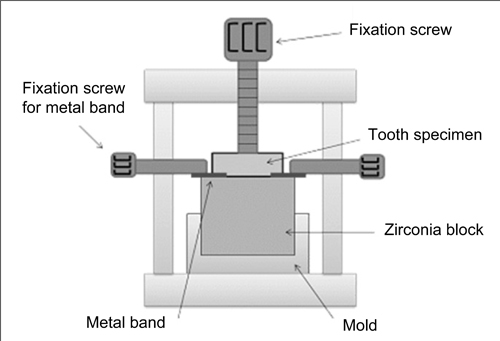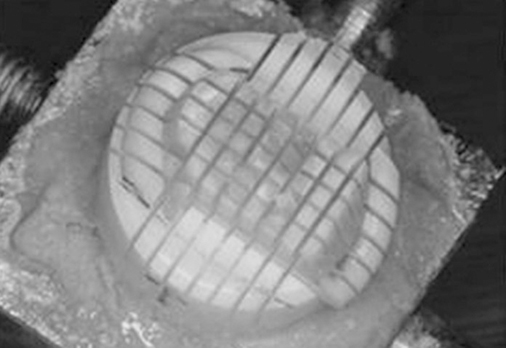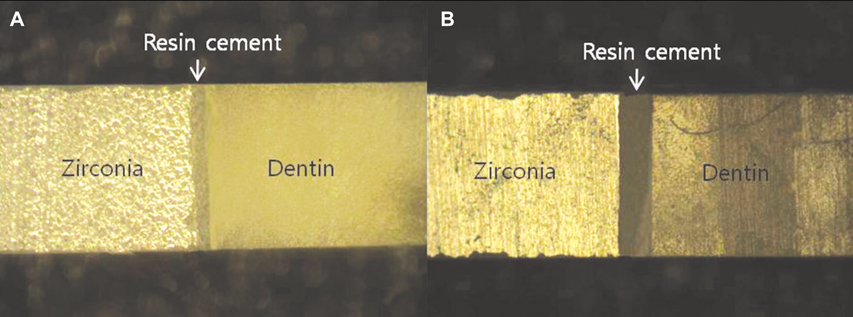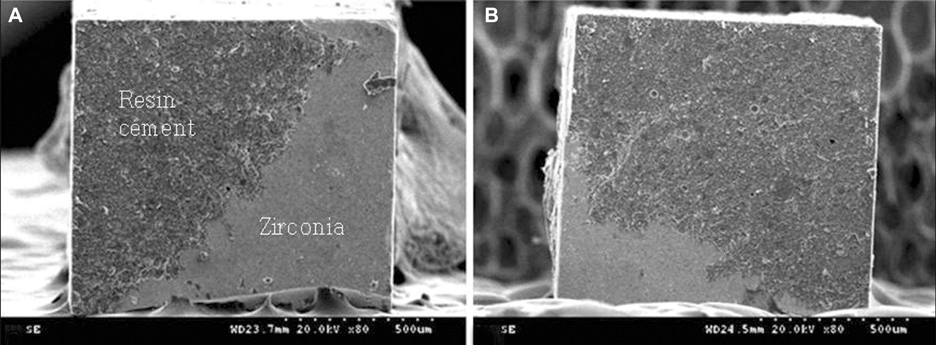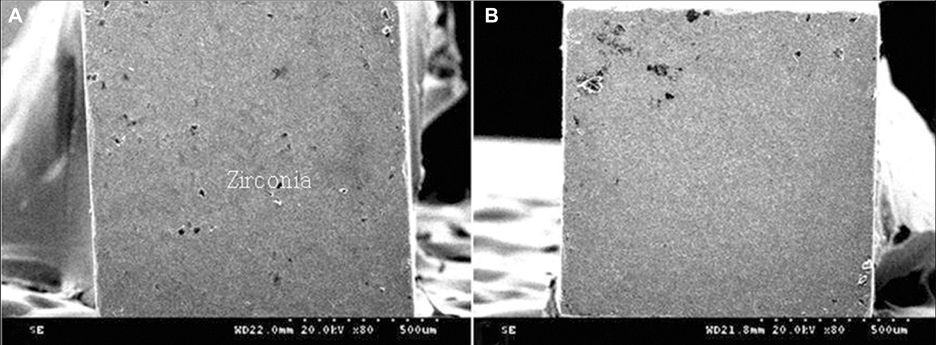J Adv Prosthodont.
2011 Sep;3(3):119-125. 10.4047/jap.2011.3.3.119.
Influence of cement thickness on resin-zirconia microtensile bond strength
- Affiliations
-
- 1Department of Prothodontics, Gangnam Severance Dental Hospital, College of Dentistry, Yonsei University, Seoul, Korea. sunjai@yuhs.ac
- 2Department of Dental Biomaterials Science, Graduate School, Seoul National University, Seoul, Korea.
- 3Department of Prosthodontics, Yonsei University Dental Hospital, College of Dentistry, Yonsei University, Seoul, Korea.
- KMID: 2118119
- DOI: http://doi.org/10.4047/jap.2011.3.3.119
Abstract
- PURPOSE
The aim of this study was to evaluate the influence of resin cement thickness on the microtensile bond strength between zirconium-oxide ceramic and resin cement.
MATERIALS AND METHODS
Thirty-two freshly extracted molars were transversely sectioned at the deep dentin level and bonded to air-abraded zirconium oxide ceramic disks. The specimens were divided into 8 groups based on the experimental conditions (cement type: Rely X UniCem or Panavia F 2.0, cement thickness: 40 or 160 microm, storage: thermocycled or not). They were cut into microbeams and stored in 37degrees C distilled water for 24 h. Microbeams of non-thermocycled specimens were submitted to a microtensile test, whereas those of thermocycled groups were thermally cycled for 18,000 times immediately before the microtensile test. Three-way ANOVA and Sheffe's post hoc tests were used for statistical analysis (alpha=95%).
RESULTS
All failures occurred at the resin-zirconia interface. Thermocycled groups showed lower microtensile bond strength than non-thermocycled groups (P<.001). Differences in cement thickness did not influence the resin-zirconia microtensile bond strength given the same resin cement or storage conditions (P>.05). The number of adhesive failures increased after thermocycling in all experimental conditions. No cohesive failure was observed in any experimental group.
CONCLUSION
When resin cements of adhesive monomers are applied over air-abraded zirconia restorations, the degree of fit does not influence the resin-zirconia microtensile bond strength.
MeSH Terms
Figure
Reference
-
1. Ozcan M, Vallittu PK. Effect of surface conditioning methods on the bond strength of luting cement to ceramics. Dent Mater. 2003. 19:725–731.2. Phark JH, Duarte S Jr, Blatz M, Sadan A. An in vitro evaluation of the long-term resin bond to a new densely sintered high-purity zirconium-oxide ceramic surface. J Prosthet Dent. 2009. 101:29–38.3. Palacios RP, Johnson GH, Phillips KM, Raigrodski AJ. Retention of zirconium oxide ceramic crowns with three types of cement. J Prosthet Dent. 2006. 96:104–114.4. Piconi C, Maccauro G. Zirconia as a ceramic biomaterial. Biomaterials. 1999. 20:1–25.5. Kosmac T, Oblak C, Jevnikar P, Funduk N, Marion L. The effect of surface grinding and sandblasting on flexural strength and reliability of Y-TZP zirconia ceramic. Dent Mater. 1999. 15:426–433.6. Janda R, Roulet JF, Wulf M, Tiller HJ. A new adhesive technology for all-ceramics. Dent Mater. 2003. 19:567–573.7. Kern M, Wegner SM. Bonding to zirconia ceramic: adhesion methods and their durability. Dent Mater. 1998. 14:64–71.8. Al-Dohan HM, Yaman P, Dennison JB, Razzoog ME, Lang BR. Shear strength of core-veneer interface in bi-layered ceramics. J Prosthet Dent. 2004. 91:349–355.9. Oh WS, Shen C. Effect of surface topography on the bond strength of a composite to three different types of ceramic. J Prosthet Dent. 2003. 90:241–246.10. Valandro LF, Della Bona A, Antonio Bottino M, Neisser MP. The effect of ceramic surface treatment on bonding to densely sintered alumina ceramic. J Prosthet Dent. 2005. 93:253–259.11. Guazzato M, Albakry M, Quach L, Swain MV. Influence of surface and heat treatments on the flexural strength of a glass-infiltrated alumina/zirconia-reinforced dental ceramic. Dent Mater. 2005. 21:454–463.12. Burke FJ, Fleming GJ, Nathanson D, Marquis PM. Are adhesive technologies needed to support ceramics? An assessment of the current evidence. J Adhes Dent. 2002. 4:7–22.13. Oyagüe RC, Monticelli F, Toledano M, Osorio E, Ferrari M, Osorio R. Effect of water aging on microtensile bond strength of dual-cured resin cements to pre-treated sintered zirconium-oxide ceramics. Dent Mater. 2009. 25:392–399.14. Wolfart M, Lehmann F, Wolfart S, Kern M. Durability of the resin bond strength to zirconia ceramic after using different surface conditioning methods. Dent Mater. 2007. 23:45–50.15. Yang B, Barloi A, Kern M. Influence of air-abrasion on zirconia ceramic bonding using an adhesive composite resin. Dent Mater. 2010. 26:44–50.16. Amaral R, Ozcan M, Valandro LF, Balducci I, Bottino MA. Effect of conditioning methods on the microtensile bond strength of phosphate monomer-based cement on zirconia ceramic in dry and aged conditions. J Biomed Mater Res B Appl Biomater. 2008. 85:1–9.17. Aboushelib MN, Kleverlaan CJ, Feilzer AJ. Selective infiltration-etching technique for a strong and durable bond of resin cements to zirconia-based materials. J Prosthet Dent. 2007. 98:379–388.18. Wegner SM, Gerdes W, Kern M. Effect of different artificial aging conditions on ceramic-composite bond strength. Int J Prosthodont. 2002. 15:267–272.19. Lüthy H, Loeffel O, Hammerle CH. Effect of thermocycling on bond strength of luting cements to zirconia ceramic. Dent Mater. 2006. 22:195–200.20. Leinfelder KF, Isenberg BP, Essig ME. A new method for generating ceramic restorations: a CAD-CAM system. J Am Dent Assoc. 1989. 118:703–707.21. Molin MK, Karlsson SL, Kristiansen MS. Influence of film thickness on joint bend strength of a ceramic/resin composite joint. Dent Mater. 1996. 12:245–249.22. Reich S, Wichmann M, Nkenke E, Proeschel P. Clinical fit of all-ceramic three-unit fixed partial dentures, generated with three different CAD/CAM systems. Eur J Oral Sci. 2005. 113:174–179.23. Kohorst P, Brinkmann H, Dittmer MP, Borchers L, Stiesch M. Influence of the veneering process on the marginal fit of zirconia fixed dental prostheses. J Oral Rehabil. 2010. 37:283–291.24. Wettstein F, Sailer I, Roos M, Hmmerle CH. Clinical study of the internal gaps of zirconia and metal frameworks for fixed partial dentures. Eur J Oral Sci. 2008. 116:272–279.25. Sailer I, Fehér A, Filser F, Gauckler LJ, Lüthy H, Hämmerle CH. Five-year clinical results of zirconia frameworks for posterior fixed partial dentures. Int J Prosthodont. 2007. 20:383–388.26. Feilzer AJ, De Gee AJ, Davidson CL. Setting stress in composite resin in relation to configuration of the restoration. J Dent Res. 1987. 66:1636–1639.
- Full Text Links
- Actions
-
Cited
- CITED
-
- Close
- Share
- Similar articles
-
- Bond Strength of Band on Zirconia Crown with Compomer and Resin Cement
- Influence of sandblasting and primer on shear bond strength of resin cement to zirconia
- Bond strength of resin cement to CO2 and Er:YAG laser-treated zirconia ceramic
- Effect of various surface treatment methods of highly translucent zirconia on the shear bond strength with resin cement
- Effect of surface treatments of zirconia ceramic on the bond strength of resin cements

